Take a ride along this famed Illinois road known for its awesome herp encounters.
Looking to the east, my gaze settled on the vibrant green of duckweed-covered swamps, and turning west, I stared up at imposing limestone bluffs. Uniquely located between the summer swamps and overwintering bluffs, the famed Snake Road of the Shawnee National Forest cuts a path right through the heart of the native snakes’ migration route. In some places, the road is the sole obstacle separating these two, distinct habitats.
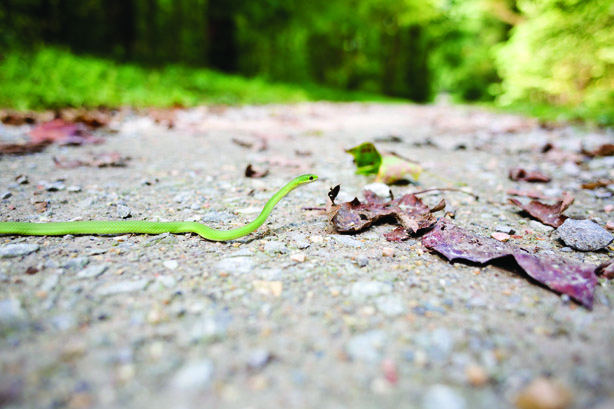
Cyrene Krey
The author came upon this rough green snake (Opheodrys aestivus) crossing the road.
This is what makes this area so alluring to snake enthusiasts. Its location ensures that during migration periods, the road will quite literally be covered with the long, slithering bodies of shelter-seeking snakes.
The road is closed twice a year for the migration, once in the spring and again in the fall. Although the months of October and April are the peak migration periods for the snakes of Snake Road, I opted instead to visit in early- to mid-September. As a first-timer to the area, I made the slightly unusual decision to arrive earlier during the road’s closure in order to avoid the larger crowds I had learned gather during the more popular October weekends.
Reptiles And Amphibians Of Shawnee National Forest's Snake Road
The number of species present along Snake Road and in the greater Shawnee National Forest is impressive. The 56 total species of reptiles and amphibians found in the area, including three species of venomous snakes and four endangered species of herpetofauna, make this a go-to destination for field herpers. But don’t expect to see them all at once. Not all species need to cross the road to reach their respective seasonal habitats and many, such as small micro-snakes, lizards and salamanders can be difficult to locate. You may need to go just beyond Snake Road to find some of these critters, but exploring other forest trails is well worth it.
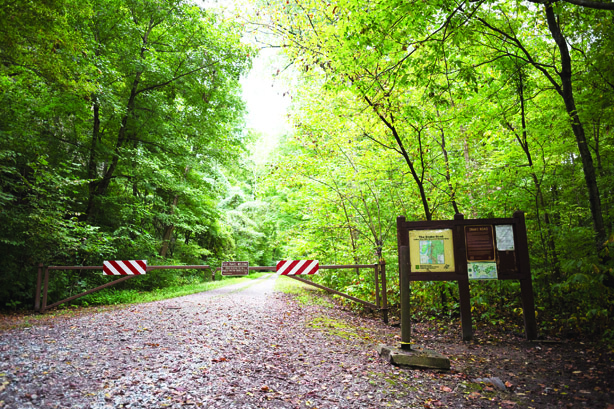
Cyrene Krey
A gate blocks the entrance to the portion of Snake Road that is closed for the annual snake migrations.
That said, Scott Ballard, a herpetologist for the Illinois Department of Natural Resources, prefers visitors remain on the road or on designated hiking trails. Although not expressly prohibited to wander beyond these designated paths, venturing off-trail disturbs habitat which poses a concern for smaller snakes and salamanders in areas with loose soil, rocks or vegetation. It also creates new paths which illegal collectors explore and exploit.
Staying on the road or trails also provides visitors the opportunity to learn from other people traveling the area. While hiking, I spoke with Samantha Stearns-Foster, a program director at the Welty Environmental Center in Beloit, Wis., who was visiting the area. Knowledgeable about the region and the best places to go to discover different herpetofauna, she showed me a location beyond the road that was ideal for observing salamanders. Gently turning over rocks and logs to look for the small amphibians, she moved slowly and deliberately, careful to avoid injuring the animals or damaging their habitats, and teaching me safe herping techniques in the process.
Finding people with more knowledge of the area, field herping and herpetology turned out to be a highlight of my trip. Although I had come for the snakes, I was also thrilled with the opportunity to engage with both experts and enthusiasts. I wasn’t alone in making interesting connections with like-minded snake-seekers. Shawn Gossman, the creator of Hiking With Shawn, a YouTube channel focusing on hiking in the Southern Illinois region, had also described sharing the road with people he’d met there and listening to their stories. Indeed, most of the individuals I encountered had a lot to say about the local history, knowledge of the reptiles of the road and stories of those they’d met. Unfortunately, not all of the narratives were pleasant.
You’ll be Fine(d) For Illegal Collecting On The Snake Road
“Probably 98 percent of the people who come out here are legal, dedicated field herpers,” Scott Ballard told me. “Only 2 percent are troublemakers.”
The minority of troublemakers he was referring to are the individuals who come to the Snake Road area to illegally collect or harass the wildlife. He said his department sees about two or three cases of wildlife being captured illegally each season. Law enforcement is quick to take action against such events though, stationing officers on the limestone bluffs overlooking the road to watch for illegal collecting. They will even review YouTube videos to find and cite harassers.
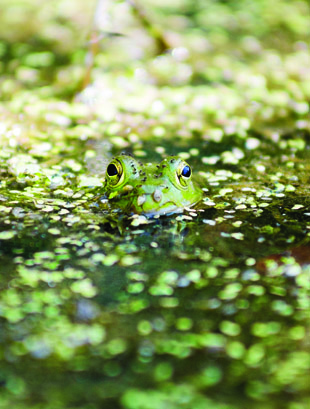
Cyrene Krey
An insect-covered bullfrog (Lithobates catesbeianus) peeks out of some swamp water.
Common items used for collecting are also prohibited; hooks, tongs and pillowcases are all considered contraband while on Snake Road. Ballard told me of a 20-something young man who attempted to leave the area with a neonate cottonmouth in a pillowcase under his shirt. “He’s lucky it didn’t bite him through the pillowcase,” he said.
John Palis, a local zoologist, confirmed law enforcement’s dedication to preventing collecting in the research area. He explained that it’s easy to strike up conversations with others exploring Snake Road and the surrounding areas while sharing the road with them. He spoke of one man he encountered.
“I didn’t like the way he was handling the snakes,” he explained, “so I got a little ways away from him.” Palis later witnessed the man being approached by a law enforcement officer wearing camouflage gear who materialized from the woods demanding to see the contents of the man’s backpack. Two small snakes in deli cups, supposedly for photographing later and releasing, was enough to result in a $500 fine. Warnings about such encounters are common anecdotes shared by regular visitors.
A group of volunteers were out the first weekend I was there, to help remove invasive plant species that are plaguing the area. One of the women leading the group warned them, “Don’t even look like you might be collecting. The DNR posts lookouts on the bluffs, and if they even suspect you might be here to collect, they’ll slap you with a large fine.”
Because Snake Road is located in the LaRue-Pine Hills-Otter Pond Research Natural Area, collecting wildlife of any kind is prohibited in accordance with federal regulations. However, permits are available to local residents for collecting within other areas of the Shawnee National Forest, while nonresidents are barred from taking wildlife home altogether.
Removing wildlife from the research area isn’t the only activity that will result in law enforcement issuing citations. “Replace everything you move,” Ballard told me. Field herpers often turn over logs, leaves and anything else that might be hiding an interesting animal. Because of the damage this can cause if such items are not placed back as they were found, doing so can earn someone a fine. “Don’t harass or harm the wildlife,” Ballard added. “We caught a video of a kid throwing snakes in the air on YouTube; harassing the animals like that will also get you a fine.”
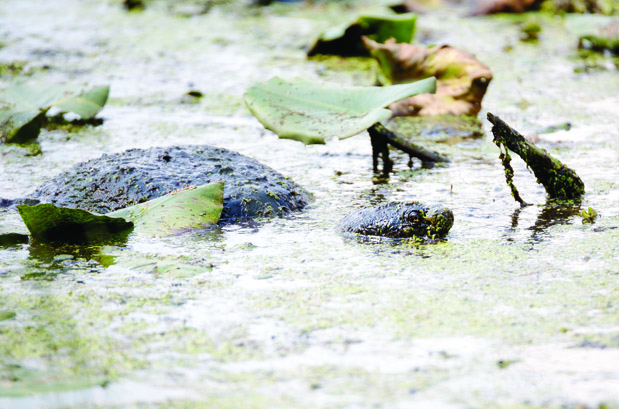
Cyrene Krey
A common snapping turtle (Chelydra serpentina) swimming in a swamp adjacent to Snake Road.
Ballard reiterated that most of the people who visit Snake Road have good intentions, and only a small percentage visit there to make trouble. Despite those good intentions, however, there is still a concern about the throngs of people who arrive during such a short span of time. “I can see around 200 people while I’m on the road during an October weekend,” he said.
“The crowds can sometimes be too much,” Stearns-Foster confided during our time walking together, referring to the groups that gather at the migration’s peak. Last year, she observed a group of teenage boys running up and down the road. This was a danger to themselves due to the abundance of cottonmouths in the area, as well as to smaller reptiles and amphibians that could easily end up under the crushing boot of carelessly placed steps.
“We’ve seen squished snakes along the road before,” Palis shared. “It’s a bit of a sacrificial place. People come here to learn about snakes, but in the process can also do a lot of damage.” But it certainly hasn’t been all dire. Palis once also watched a boy who was filling a garbage bag with some of the litter that accumulates from traffic when the road is open. Thankfully, the bad apples seem few and far between, and with a little bit of education, people can safely visit Snake Road without causing harm to the animals or their environment.
Snake Road Crowds: Stay Home On Weekends
Keeping in mind a few key points can maximize the success of any trip to Snake Road. According to both Palis and Ballard, visiting when there are fewer people is best. While the first weekend of October and the third week of April are when most of the snakes are migrating, there are good reasons for avoiding the crowds at those times. According to Ballard, “When no one is here is best.” He explained that the vibrations caused by so many feet walking along the road tend to scare off a number of animals.
“Come during the week, and avoid the weekends when most people come out,” Palis suggested. While there are still people along Snake Road during the week, the crowds are generally smaller. This allows for more intimate viewing and also increases opportunities for leisurely conversations with dedicated weekday field herpers.
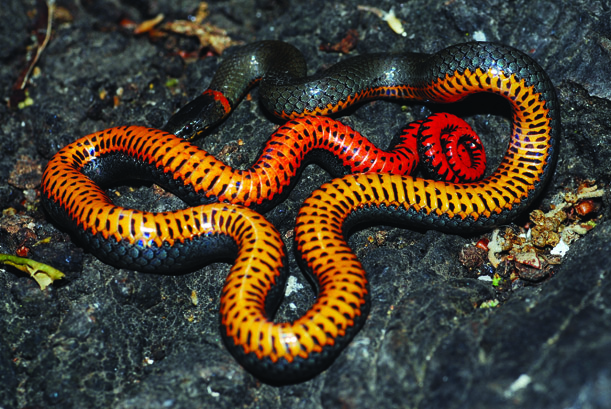
jason mintzer/shutterstock
The ring-necked snake (Diadophis punctatus) is one of the many harmless snakes that inhabit the area. This one is showing its bright belly coloration during a threat display.
While there were moments of relative quiet during my September weekend visits, the road was already predominantly active with people, despite it being pre-peak migration. Some of the visitors I encountered sauntered along slowly with their gazes firmly planted on the road beneath their feet, while others power-walked their way to each gate, content with just a fleeting glimpse of the defining white mouth of the ever-so-common cottonmouth.
The snakes blend in to the tall grasses and leaf litter, and smaller reptiles and amphibians are hard to spot at a quick pace. In order to optimize snake viewing, it takes more than just coming during the road’s closure and keeping a slow and steady pace — weather is also a significant factor. Because reptiles are ectothermic, and environmental conditions play a significant role in their body temperatures, some herpers assume the hotter the better when seeking out snakes. Instead these Goldilocks-like animals need temperatures that are neither too hot nor too cold, but just right. When temperatures are in the mid-70s Fahrenheit is when things are generally most active along Snake Road. Recent rainfall should also be considered. Based on conversations with locals, it was a little drier than usual when I went. Ballard suggested visiting after a decent rain, because the snakes tend to hunker down and stay off the road when it’s hot and dry.
Snakes Of Shawnee National Forest's Snake Road
The cottonmouth (Agkistrodon piscivorus) is the most common snake seen along Snake Road. So common, in fact, that stumbling over them isn’t hard to do. Cottonmouths are well camouflaged and are everywhere. “Leave the pets at home and keep your kids on leashes,” Ballard joked, explaining that a cottonmouth often sees you before you see the cottonmouth. For this reason, he strongly recommends wearing proper hiking boots to protect your feet from the venomous snakes.
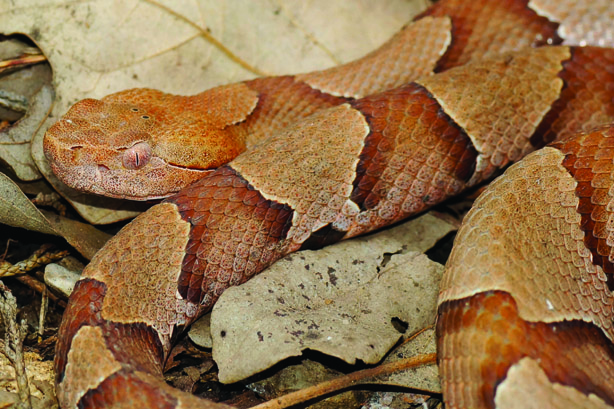
matt jeppson/shutterstock
The copperhead (Agkistrodon contortrix) is another well-camouflaged species you want to avoid stepping on.
Although their venom and common misconceptions about snakes result in a general dislike of the animals, Ballard said that there are rarely problems resulting from snake bites. I found that walking at a leisurely pace and keeping an eye on the grasses along the sides and in the middle of the road kept me from accidentally startling any snakes, but even then, there were a few times when I found myself looking down at a snake that was just inches from my feet.
Snakes and other herps aren’t the only things visitors should pay attention to when hiking along Snake Road. Eye-catching scenery and other wildlife abounds. Talkative birds, the beautiful limestone bluffs, colorful swamps and, when I was there, the soon-to-be explosion of fall colors were just some of the other natural elements to be appreciated when visiting during the autumn road closure. Armadillos were also making regular appearances at the time, much to the delight of visitors.
Nine days didn’t seem long enough to fully explore Snake Road, but it was more than enough time to instill a familiarity with the local residents. Returning to my campsite on my last night, I was greeted by a cottonmouth. After seeing so many of them along the road, though, I felt perfectly comfortable sharing my camp with this scaly roommate.
This is a common theme of the discussions around Snake Road. Although crowds, trampling and illegal collecting can be problems, the annual road closure of Snake Road is the only one in the U.S. that’s enforced specifically to protect snakes during their migration. Scott Ballard told me that he’s been on tours of the area with people who start out afraid of snakes, but by the end their fear is gone. “Once they see them up close and they learn about them, that fear just goes away. People have to see it to want to protect it,” he said, referring both to the animals and the habitats they depend on for survival. “So we do as much positive as we can and leave the bad apples for law enforcement.”
As a budding field herper, I relished the opportunity to explore the beautiful and intriguing Snake Road area as one of my first herping experiences. Keeping in mind the advice of experienced field herpers and knowledgeable wildlife professionals can help make any experience along the road both safe and memorable.
Cyrene Krey is a wildlife photographer with a Master’s degree in Biology. She lives in Illinois with her husband and a houseful of rescue critters, including one spoiled uromastyx and two baby ball pythons. Her photography can be seen at cyrenekrey.com.


